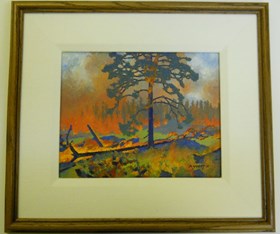Narrow Results By
- Date
- 2011
- Medium
- oil on wood
- Catalogue Number
- GuR.02.01
- Description
- A landscape oil painting, on board, of forest on fire. The painting is dominated by one central tree. Fallen tree on fire diagonally across painting in foreground. Background is thick forest on fire and some blue sky with orange smoke. Primarily red, green, blue and yellow color palette. Au verso s…
1 image
- Title
- #4 Wildfires
- Date
- 2011
- Medium
- oil on wood
- Dimensions
- 19.2 x 24.3 cm
- Description
- A landscape oil painting, on board, of forest on fire. The painting is dominated by one central tree. Fallen tree on fire diagonally across painting in foreground. Background is thick forest on fire and some blue sky with orange smoke. Primarily red, green, blue and yellow color palette. Au verso several stickers. At top white with black printing “THIS PAINTING HAS BEEN DONATED TO THE PERMANENT COLLECTION OF THE WHYTE MUSEUM OF THE CANADIAN ROCKIES AT BANFF. IT IS A GIFT FROM THE ARTIST, ROBERT GUEST OF GRANDE CACHE. 2012.” Sticker middle right is yellow with black print, “ CAUTION! HELP AVOID FADING: Display original artwork out of direct sunlight or other strong light, and away from heat or moist conditions!” Bottom left label, white with black printing, “#4. Wildfires./2011” NEW OILPAINT SERIES - 8X10 “ PANELS AT GRANDE CACHE, BY R. GUEST.” Bottom left sticker, blue with black print, see artist bio.
- Subject
- landscape
- forest fire
- Robert Guest
- Credit
- Purchased from Robert Guest, Grande Cache, 2012
- Catalogue Number
- GuR.02.01
Images
This material is presented as originally created; it may contain outdated cultural descriptions and
potentially offensive content.
Read more.
Dark days at noon : the future of fire
https://archives.whyte.org/en/permalink/catalogue26239
- Medium
- Library - Book (including soft-cover and pamphlets)
- Published Date
- 2022
- Author
- Struzik, Edward
- Publisher
- Montreal ; Kingston ; London ; Chicago : McGill-Queen's University Press
- Call Number
- 04 St8d
- Author
- Struzik, Edward
- Publisher
- Montreal ; Kingston ; London ; Chicago : McGill-Queen's University Press
- Published Date
- 2022
- Physical Description
- ix, 291 pages : illustrations (chiefly colour), colour map ; 27 cm
- Abstract
- The catastrophic runaway wildfires advancing through North America and other parts of the world are not unprecedented. Fires loomed large once human activity began to warm the climate in the 1820s, leading to an aggressive firefighting strategy that has left many of the continent's forests too old and vulnerable to the fires that many tree species need to regenerate. Dark Days at Noon provides a broad history of wildfire in North America, from pre-European contact to the present, in the hopes that we may learn from how we managed fire in the past, and apply those lessons in the future. As people continue to move into forested landscapes to work, play, live, and ignite fires--intentionally or unintentionally--fire has begun to take its toll, burning entire towns, knocking out utilities, closing roads, and forcing the evacuation of hundreds of thousands of people. Fire management in North America requires attention and cooperation from both sides of the border, and many of the most significant fires have taken place at the boundary line. Despite a clear lack of political urgency among political leaders, Edward Struzik argues that wildfire science needs to guide the future of fire management, and that those same leaders need to shape public perception accordingly. By explaining how society's misguided response to fire has led to our current situation, Dark Days at Noon warns of what may happen in the future if we do not learn to live with fire as the continent's Indigenous Peoples once did. -- Provided by publisher.
- Contents
- Introduction -- 1. Prelude to the dark days at noon -- 2. The fire triangle -- 3. More dark days coming -- 4. The big burn -- 5. Big burns in Canada -- 6. Paiute forestry -- 7. Fire suppression -- 8. The Civilian Conservation Corps -- 9. Canada's Conservation Corps -- 10. The fall of the Dominion Forest Service -- 11. The royal commission into wildfire -- 12. White man's fire -- 13. International co-operation -- 14. Blue moon and blue sun -- 15. Nuclear winter -- 16. Yellowstone: A turning point -- 17. Big and small grizzlies -- 18. Climate and the age of megafire -- 19. The holy shit fire -- 20. The Pyrocene -- 21. Nuclear winter: Part two -- 22. Owls and clear-cuts -- 23. Water on fire -- 24. The Arctic on fire -- 25. The big smoke -- 26. Fire news -- Conclusion.
- ISBN
- 9780228012092
- Accession Number
- P2024.02
- Call Number
- 04 St8d
- Collection
- Archives Library
This material is presented as originally created; it may contain outdated cultural descriptions and
potentially offensive content.
Read more.
The language of fire - interview with Parks Canada Gregg Walker
https://archives.whyte.org/en/permalink/catalogue916
- Medium
- Library - Periodical
- Published Date
- 2018
- Author
- Wilson, Niki
- Publisher
- In Canadian Rockies Annual, Vol. 3, 2018
- Call Number
- P
- Author
- Wilson, Niki
- Editor
- Ward, Meghan J.
- Publisher
- In Canadian Rockies Annual, Vol. 3, 2018
- Published Date
- 2018
- Physical Description
- p.48-53
- Medium
- Library - Periodical
- Subjects
- Fire ecology
- Fire fighting
- Fires
- Parks Canada
- Banff National Park
- Kootenay National Park
- Waterton-Glacier International Peace Park
- Mount Assiniboine Provincial Park
- Abstract
- Wildfires play an important role in the landscape. But when they burn out of control, professionals dive in to manage them. Fire expert Gregg Walker explains what's really going on amidst the flames
- Language
- English
- Call Number
- P
- Collection
- Archives Library
This material is presented as originally created; it may contain outdated cultural descriptions and
potentially offensive content.
Read more.



